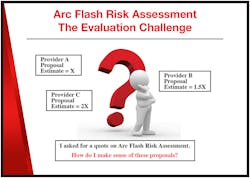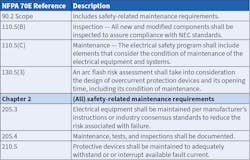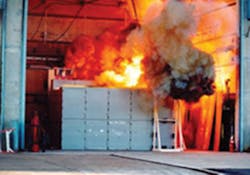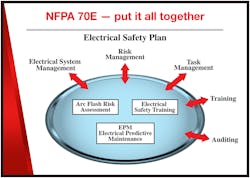As facility managers look to evaluate proposals for an arc flash risk assessment, a common issue often surfaces. It’s difficult to sort out the project scope and significant differences in proposals (Fig. 1). In addition, as bids are solicited for an arc flash risk assessment, oftentimes there is an assumption that NFPA 70E, Standard for Electrical Safety in the Workplace, is the standard — which leads to the misconception that the company does not have to create its own scope of work specifications.
An arc flash risk assessment project is broken down into the following project phases:
- Phase 1 ― data collection.
- Phase 2 ― engineering analysis, which includes at a minimum the arc flash incident energy calculations and the data for label printing.
- Phase 3 ― implementation.
- Phase 4 ― ongoing management of the arc flash program.
The arc flash risk assessment project scope can be designed to include many 70E requirements that are easily integrated into the deliverables of each phase. The arc flash study should not be a one-time project. Instead, it should establish a baseline plus the management of an ongoing program. A better approach to the arc flash study project assessment (and vendor decision) is to develop a five-year plan of managing the 70E requirements within the arc flash project deliverables.
Don’t rely on price alone
The project commitment for an arc flash risk assessment cannot be made by price only. The challenge in evaluating proposals for arc flash study work is understanding the project scope and asking the question (when estimate price points are very different): What is included in proposal No. 1 and not in proposal No. 2? The best evaluations should also include a strong knowledge base of the 70E standard to identify what is not included. What is not known or understood by the decision-makers is a key factor that points to prices, not results. However, there is often post-project regret when facility managers identify areas of non-compliance that could have been addressed by a fully integrated arc flash risk assessment.
It should be noted that various discrepancies in project scope should not be considered “incorrect” — a better term is “incomplete.” The 70E standard offers no specific guidance with regard to project scope but simply assumes that a variety of programs and safety initiatives within the organization will be used to assure compliance.
To best understand the elements of the arc flash risk assessment, it’s important to examine each project phase and compare the scope of work of a fully integrated arc flash study to examples of how the project scope and price were reduced within a competing vendor’s proposal.
Phase 1: Data collection
The best practice of data collection is to use a software platform to develop a profile of each component within the electrical system. The software seeks not only to document the data attributes needed for the arc flash study, but also to support testing protocols such as infrared, ultrasonic, and visual inspection. The software could also be extended to manage the overall condition of maintenance tasking for all components in the electrical system supporting future site visits. A robust data collection project scope will meet the following 70E standards (see Table).
The software platform provides reporting at the inventory level of devices and their attributes. It also offers problem reporting to note any deficiencies of the electrical components in terms of either NEC violations or other reliability/risk factors that improve the likelihood that an arc flash incident could occur. The last specification is the ability to track future site visits to document periodic maintenance tasking or repairs.
Data collection is typically the majority of the price and project scope differences among proposals. A common and very limited approach to Phase 1 is to develop the device profiles within a limited “labels only” project scope. This approach seeks to gather only the elements needed to produce the arc flash label data. This can be referred to as the “clipboard method” of data collection. The final result of the clipboard method typically is some paper-based note pages. From these pages, the Phase 2 engineering model is built. However, oftentimes these pages are filed and forgotten, leaving little to no benefit to future management of the arc flash program. Therefore, a deeper review of Phase 1 data collection should focus on the broader list of the applicable 70E requirements and determine if the company will seek to comply with these items with other perhaps existing systems.
Phase 2: Review
The core deliverable of Phase 2 is the build-out of the facility’s electrical distribution system within the engineering software. One of the first discussion points is the accuracy of this model. Without a more detailed Phase 1 data collection, many inaccuracies can be introduced into the model. For example, what used to be an installed 100A disconnect was replaced with a 60A disconnect, but the existing wiring was repurposed. The wire size affects the incident energy calculated result.
The second area of emphasis is the use of “assumptions.” Within the arc flash engineering study, the use of assumptions can be based upon the result that the data collection was not fully complete. For example, a report that specifics a specific fuse type and class in use throughout the electrical system could be a listed assumption. However, this assumption was made as a means to reduce data collection — but to populate the engineering model, this is the value as entered. In some project reports, the declaration of these assumptions was not included.
A fully integrated arc flash risk assessment will seek to include the following elements in the Phase 2 results:
- a short circuit audit,
- an identification of mis-coordinated device pairings,
- the incident energy results, and
- a report of the facilities breaker settings.
A more narrow project could necessitate presenting only the incident energy results and not include a discussion or presentation of these other areas. Even when the additional views of data are included in the Phase 2 reports, a deeper explanation of the study results interpreted to 70E standards are not included. Several facility managers described the experience that the study report was provided along with a package of labels, and the project was considered complete.
The discussion of hazards identified and hazard resolution [Sec. 110.1] are not addressed. The Phase 2 results also lay the groundwork of several topics within the electrical safety plan, including device access by in-house qualified individuals and PPE safety equipment standards.
Phase 3: Implementation
In a fully integrated arc flash risk assessment, Phase 3 includes:
- Project results review (preliminary findings and findings resolution)
- Label deployment
- Qualified and unqualified electrical safety training
- Project wrap-up
- Developing an overview of Phase 4 ongoing program management (Phase 4)
The overall objective of Phase 3 is to use the data collected in Phase 1 and Phase 2 to develop and implement the electrical safety policies and practices of the 70E standard. One facility manager described an arc flash study project that ended with an email of the study report and a box of labels. Another example cited a study report of more than 500 pages of charts and data from the engineering software, but provided little in the way of 70E standards and interpretation.
Phase 4: Ongoing program management
Once the baseline study is complete, Phase 4 builds out the plan for keeping the program current and preserving the investment in this project. The ongoing program management will include changes and updates to the electrical system, new standards as published by the NFPA every three years, and the safety training and skills development of your sites qualified individuals. Many of the decisions of managing the ongoing program will be key points to document within the site electrical safety plan.
The Role of the Electrical Safety Plan
Beyond the arc flash risk assessment, NFPA 70E also requires a written electrical safety program. Within the effort of developing the electrical safety program, the facility will need to document what programs and processes address 70E compliance challenges. For facilities seeking to adopt a more specific arc flash project scope than the fully integrated arc flash risk assessment, as described, it is recommended to first develop the electrical safety program. This effort will identify what expectations to meeting 70E standards are placed upon which internal system. The “gap analysis” of what is in place today versus compliance with 70E standards will be uncovered during this development effort. The electrical safety plan (Fig. 2) can become your guide to the successful implementation of an NFPA 70E program.
Do not take on this endeavor lightly. The development of the electrical safety plan can be a formidable task. Refer to the previously published EC&M article, “Meeting the 2018 NFPA 70E Challenge,” to get started.
Chuck Fox is the general manager of The Electrician Inc.’s Specialty practice division, providing electrical testing and NFPA 70E compliance services. He has held the NFPA Certified Electrical Safety Compliance Professional CESCP) certification since 2014. He can be reached at ChuckF@TheElectricianInc.
About the Author
Chuck Fox, CESCP
Owner
Chuck Fox is the president and founder of PowerSafe Consulting. He’s been an NFPA Certified Electrical Safety Compliance Professional since 2014. He can be reached at [email protected].





